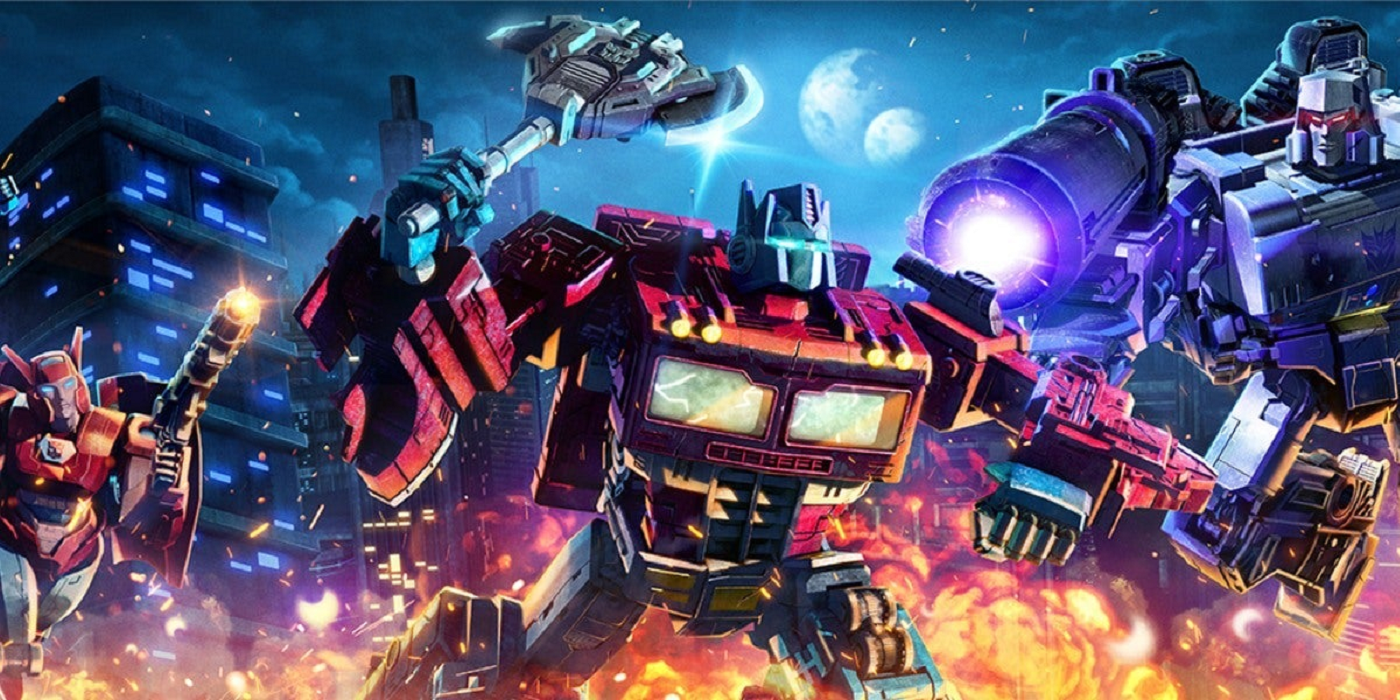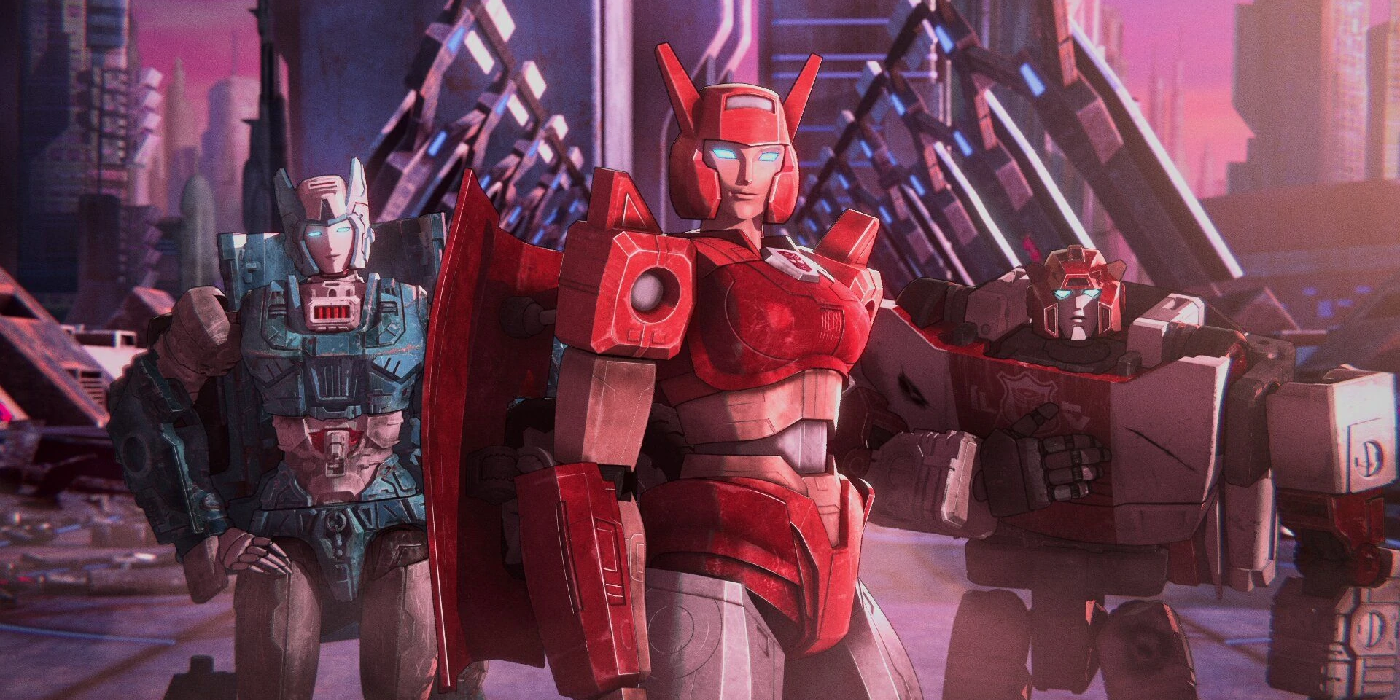For almost 40 years, Transformers has been one of the most iconic entertainment franchises in the world. Entertaining generations of fans with its own different generations of content, the iconic toy series is also an incredible success story between both its Japanese and American incarnations.
With the recent War for Cybertron anime trilogy on Netflix, the synergy between both the series’ international roots and different incarnations was made more apparent than ever. With the upcoming art book dedicated to the War for Cybertron coming out this fall from Viz Media, GameRant talked to series showrunner F.J. DeSanto and producer Mike Avila about the inspirations and creation behind the show.
GameRant: Looking over some material for the upcoming art book, you can definitely sense the passion the War for Cybertron anime had for Transformers, the different eras of the property and the way these different phases and characters could be brought together. When you were adapting a property with so many different phases and eras to draw on, what were some of the biggest influences over the years and how did you hope to add on to that tradition?
War for Cybertron showrunner F.J. DeSanto: It’s really simple, in that the freedom we were given with the project was based around what Hasbro was doing with the toys. We knew what the framework of where they were taking it in terms of the tone and the direction was, and then the big sucker punch was getting the characters from the Beast Wars era to eventually come in. We knew it was gonna be a prequel to G1 Transformers, so we carefully studied the original Transformers, as well as the anime that kind of came on the tail-end of the original series, the older comics imprint from Marvel, and then the shows from the Beast Wars era. All of our writers were picked because they had an affection for those particular eras of the IP. If you start going into all of the other series and everything with something as long and storied as Transformers, you’re gonna dive down a black hole you’re never gonna get out of.
GameRant: Interesting! Because we’re on a game website, one of the big things that’ll come to some of our readers’ minds would be the similarly-titled War for Cybertron video games that were on a lot of the bigger game consoles from the early 2010s. Were these an inspiration, or were you kind of doing your own thing?
DeSanto: Not very directly, no, actually. I think there’s some tonal similarities, but that’s all from Hasbro and we were trying to adapt it for a narrative show. Making a show is definitely very different from developing a game, and I think from a tonal and visual standpoint those games are definitely spiritual cousins, if that makes sense. We had played those games and were all pretty familiar with it, but truth be told it wasn’t something we were actively mining in part of the creative process for the anime.
GameRant: And as you touched on, in a lot of previous Transformers animated series, many of them have always had a strong tonal focus as either being an American animated series, or a Japanese anime series. But with this new project, it’s a really strong synergy between its status as an anime in production and its American influence on the development end. That must have been a really interesting production flow.
DeSanto: We were really helped out in that the studio, Polygon Pictures, had a lot of previous experience on other Transformers projects and on a lot of international animation co-productions in general. The creative development and writing were all done in Burbank, and we were working with a very tight-knit team on that front. With that, we were getting some help with Rooster Teeth on the resources and business end, and we could start sending things over to Japan to work on the visualization and storyboarding ahead of the actual full-on creation of the anime. After the animating, a lot of the sound-design was worked on in America, and then we sent it back off finally to Netflix in Japan. It was the anime division of Netflix in Japan that we worked with in terms of finalizing everything before it ultimately went out. The collaborative element was definitely a sort of unique process, but it gave a lot of strength that really made the show what it was.
War for Cybertron producer Mike Avila: And that goes back to one of the most interesting things I realized when we were compiling a lot of this stuff for the upcoming book, which was how much they enjoyed this method of collaboration. The team at Polygon in Japan in particular enjoyed the freedom from both Hasbro and the writing team on how to bring the visuals out. Without that trust that was given to them, the show wouldn’t have turned out the way it did.
DeSanto: The book really did do a great job of illustrating how the show was made, and the show was made, fortunately, because of the collaboration, with very few speed bumps.
GameRant: One of the things that stood out in the processes that’s coming out in the book was the way that the voice lines were initially recorded and sent out. Mind sharing a bit more on that?
DeSanto: The one thing we did that ended up making that part so strong, and this was actually the idea of our supervising producer Matt Murray who was responsible for this, was that we filmed all of the voice actors when they did their lines. We got the way their faces moved with the lines, so that the animators in Japan were able to use all of that visual information to bring it out. Of course, with some of the Transformers—you don’t see Optimus’s mouth anyway—but it makes for a huge help for getting a lot of the visual information across that language barrier between Japanese and English.
GameRant: It seems like the different studios were really suited to a project like this, actually. You have Polygon, which has experience working with Hasbro and Transformers that they were able to bring; but you also had RoosterTeeth. A lot of readers on a site like ours have memories of RoosterTeeth from back in the day, where they made animations out of video game clips from Halo and were really able to kind of get the vibe of this CGI character acting. What was it like working with them for something as big as Transformers?
DeSanto: The collaboration with RoosterTeeth had its strength more on the business side of things. We got to use their business infrastructure for a lot of it, and our involvement with them was actually something that resulted from a lot of the Warner Bros. mergers that were going on at the time. They were an animation company that kind of came in, internally from WB, and were able to bring in a lot of their experience in animation to really get a lot of it going on the logistics end. It was their strength to make things go smoother on the business end and work with Netflix for a lot of the logistics of really getting things out there during both the business stuff going on at WB and, later, during covid. We’d already delivered, I think the entire first season once the pandemic had hit? Rooster Teeth had definitely helped out with streamlining the logistics, and we definitely needed it during that moment.
GameRant: And this definitely sounds like Hasbro was big on synergizing the anime with the collectibles. What did that process look like?
DeSanto: That’s a great question. I had been involved with a smaller-scale Transformers show, Prime Wars, that really started that relationship and set the stage for a lot of what we were able to do in War for Cybertron. Because of that trust and our desire to keep the anime as authentic to the toys as possible for Cybertron, Hasbro had actually sent us over the CAD data and the model sheets for the toys themselves. You’ll see a lot of that in the book, actually. For some of the more niche characters that weren’t yet in production in the toylines, they had gave us some of the files dating all the way back to the ‘80s.
GameRant: And with that sense that this series, that it both went to the roots of the franchise and sort of updated it with the G1/Beast Wars collaboration, what was the kind of response you got from the fans, or some surprises from the analytics data at Netflix?
DeSanto: When you toy with two different eras like that, I still get hate messages from some of the more purist fans on social media *laughs* No, but a big thing we learned as a surprise was that we developed this show for an older audience who were more familiar with the inspirations. After the first season went up, we learned that a lot of the younger audience watching it was being introduced to it, introduced to that older style when watching it with their parents. They had their nostalgia, but they were able to introduce it to their kids. I’m hoping that in the future, this might be the kind of thing that kids today can point to as their entry-point into Transformers.
Avila: I think one of the things that’s going to age very well with this show is the meeting between the G1 Transformers and the Beast Wars era. I know there was a bit of fanboy hesitation, or perhaps even outrage over the whole multiverse aspect we were going for. But I hope that the more you watch it, you can see how we were trying to make something that would be so cool as a concept and with so much potential that I think turned out really well. This was something Transformers fans had had in their minds for years, and I’m really hoping we can point to the reveal as a great payoff for it. That was the big hook for the end of the trilogy, and that’s what you get to see in the art book.
The Transformers: War for Cybertron Trilogy Art Book will be available this October, published by Viz Media. The War for Cybertron Trilogy is streaming now on Netflix.


